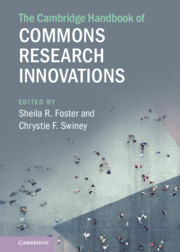Book contents
- The Cambridge Handbook of Commons Research Innovations
- The Cambridge Handbook of Commons Research Innovations
- Copyright page
- Contents
- Figures
- Tables
- Contributors
- Introduction
- Part I Revisiting the Origins and Evolution of Commons Thought
- Part II Averting New Tragedies
- Part III New Forms of Contested Commons
- Part IV Urban Landscape and Infrastructure as a Commons
- Part V Reassessing Old and New Institutions for Collective Action
- Part VI Managing and Restoring the Commons
- Part VII Law, Legal Theory, and the Commons
- 21 Prior Appropriation as a Response to the Tragedy of the Commons
- 22 Using the Public Trust Doctrine to Manage Property on the Moon
- 23 A Biotechnology “Regulatory Commons” Problem
- 24 Can Affirmative Action Offer a Lesson in Fighting Enclosure?
- Part VIII Technology, the Internet, and the Future of Commons Governance
- Index
23 - A Biotechnology “Regulatory Commons” Problem
from Part VII - Law, Legal Theory, and the Commons
Published online by Cambridge University Press: 29 October 2021
- The Cambridge Handbook of Commons Research Innovations
- The Cambridge Handbook of Commons Research Innovations
- Copyright page
- Contents
- Figures
- Tables
- Contributors
- Introduction
- Part I Revisiting the Origins and Evolution of Commons Thought
- Part II Averting New Tragedies
- Part III New Forms of Contested Commons
- Part IV Urban Landscape and Infrastructure as a Commons
- Part V Reassessing Old and New Institutions for Collective Action
- Part VI Managing and Restoring the Commons
- Part VII Law, Legal Theory, and the Commons
- 21 Prior Appropriation as a Response to the Tragedy of the Commons
- 22 Using the Public Trust Doctrine to Manage Property on the Moon
- 23 A Biotechnology “Regulatory Commons” Problem
- 24 Can Affirmative Action Offer a Lesson in Fighting Enclosure?
- Part VIII Technology, the Internet, and the Future of Commons Governance
- Index
Summary
This chapter explores a “regulatory commons” problem of jurisdictional mismatch and overlap in fragmented legal regimes that adversely impacts regulatory opportunities to address social ills at federal, state and local levels. Three Hawai‘i counties adopted ordinances addressing perceived environmental and health risks associated with genetically engineered (GE) seed crops. The ordinances relied on self-effectuating 1978 state constitutional amendments that established environmental rights and public trust responsibilities consistent with Native Hawaiian cultural values, which recognize rights and responsibilities in the management of natural resources for the benefit of present and future generations. Applying a critical contextual analysis, this chapter exposes how federal court decisions invalidating the ordinances based on implied state preemption ignored the Hawai‘i Constitution and case law. Notwithstanding significant gaps in both federal and state regulation of GE seed crops, the federal courts’ superficial analysis of supposedly “comprehensive, uniform and exclusive” statutory schemes is based on regulatory assumptions of “substantial equivalence” that are essentially appeals to ignorance. Decades-old federal policy choices assigning risks associated with scientific uncertainty to future generations will continue to tip the balance of interests in favor of industry unless appropriate corrective action is taken by Hawai‘i’s legislature, relevant administrative bodies, or the state judiciary.
Keywords
- Type
- Chapter
- Information
- The Cambridge Handbook of Commons Research Innovations , pp. 273 - 283Publisher: Cambridge University PressPrint publication year: 2021



